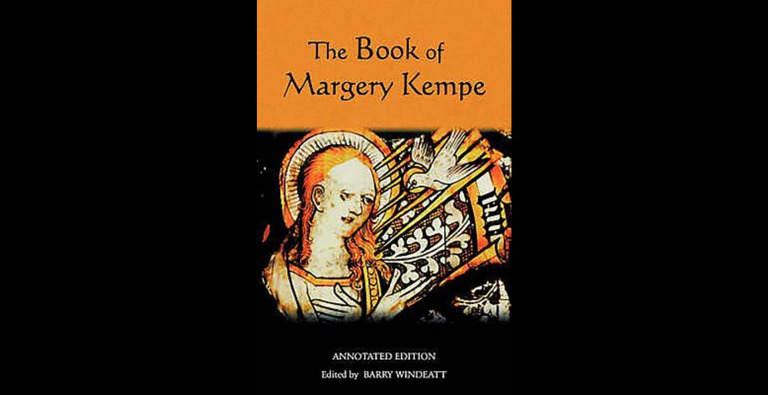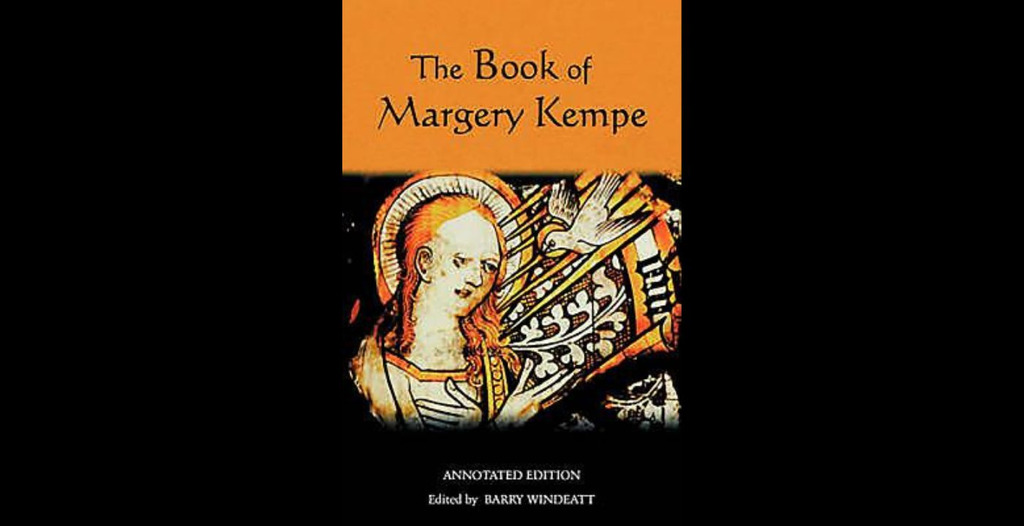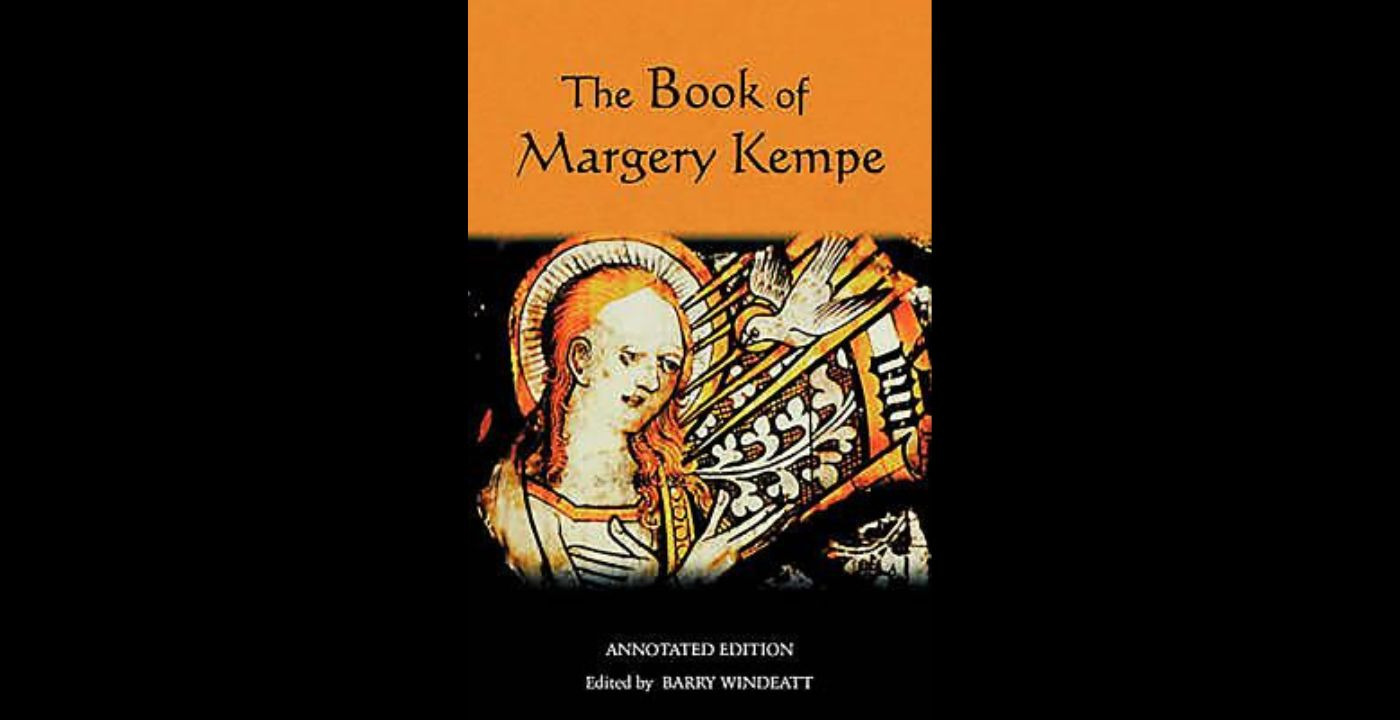Birth
c. 1373, in King’s Lynn, Norfolk, East Anglia, UK [n.b. King’s Lynn was known as ‘Bishop’s Lynn’ until 1537]
Death
Died c. 1440, King’s Lynn, Norfolk, East Anglia, UK
Religion
Roman CatholicMargery Kempe was a Roman Catholic mystic who engaged directly, as she describes in her Book, The Book of Margery Kempe, with Jesus, Mary, saints, demons, and the Holy Spirit who sometimes takes the form of sounds, or melodies, in her ear.
The Book of Margery Kempe, is considered the first autobiography in the English language.
Personal Information
Name(s)
Margery Kempe
Date and place of birth
Born, c. 1373, in King’s Lynn, Norfolk, East Anglia, UK [n.b. King’s Lynn was known as ‘Bishop’s Lynn’ until 1537]
Death and place of death
Died c. 1440, King’s Lynn, Norfolk, East Anglia, UK
Family
Mother
The identity of Margery’s mother is sadly unknown, but she was likely a member of the upper burgher class of King’s Lynn in East Anglia.
Father
John Burnham (d. 1413) was a wealthy merchant, who served as the mayor of King’s Lynn five times and was a member of parliament for Lynn six times.
Marriage and Family Life
Margery married John Kempe when she was about the age of 20 and gave birth to fourteen children, none of whom is mentioned by name in her Book, from which most of her contemporary biographical information derives.
Education
Though she was the author of the first autobiography in English, Margery was illiterate in the more modern sense of literacy. Her autobiography was dictated to two scribes. However, Margery knew (had heard read) the most important devotional and religious texts circulating in fourteenth-century England. She also regularly attended sermons and sought out persons educated in religion, including hermits, monks, anchorites, and priests. As shown in her Book, Margery’s knowledge of the Bible and biblical commentaries is extensive. She further cites the Revelations of St Bridget of Sweden, Walter Hilton's Scale of Perfection and the Stimulus Amoris (The Prick of Love), sometimes attributed to Hilton), which her priest read to her, along with the Incendium amoris (The Fire of Love) of Richard Rolle among other mystical writings. She also knew of the lives of the Beguine saint and healer Marie d'Oignies (d. 1213), who had a chaste marriage (to which Margery herself aspired, much to the chagrin of her husband), of St. Elizabeth of Hungary (d. 1231) and St. Bridget of Sweden (d. 1373), both of whom were married with children. Marie d’Oignies was, like Margery, known for her uncontrollable tears as a religious expression. Elizabeth of Hungary was also said to weep uncontrollably. These women served as models for Margery’s behaviour and emotional responses during her spiritual journey. Kempe probably derived her Passion narratives and allusions from Nicholas Love’s Meditationes vita Christi (Meditations on the Life of Christ), a well-known religious text composed in Middle English that was popularly read in Margery’s lifetime. Striking aspects of her Book are Margery’s mention of the specific titles of the religious works she has encountered, which is unusual in medieval narratives, and her remarkably retentive memory.
Religion
Margery was a Roman Catholic mystic who engaged directly, as she describes in her Book, with Jesus, Mary, saints, demons, and the Holy Spirit who sometimes takes the form of sounds, or melodies, in her ear. Margery says repeatedly that God and other holy figures have spoken to her personally. Her dramatic religiously-inspired weeping, often in very public places, caused various contretemps, especially with Henry Bowet, who served as archbishop of York from 1407until his death in 1423. Bowet was a staunch opponent of Lollardy, also known as the Wycliffite movement. Kempe was sometimes accused of heresy or of being a follower of John Wycliffe (d. 1384, see Controversy), but despite her pugnacious promotion of her own religious agenda, Margery remained within the Roman Catholic Church.
less
Significance
Works
The text of Margery’s Book survives in only one manuscript (British Library Add. MS 61823) and was copied about 1450 by an East Anglian scribe named Salthows. This manuscript was later owned by the Yorkshire Carthusian priory of Mount Grace. This is not the original copy of Margery’s Book but is very close to it. Very limited excerpts from Kempe’s Book were published by Wynkyn de Worde in 1501 and later in 1521 by Henry Pepwell with part of the title reading “taken out of the boke of Margery Kempe ancresse of Lynne.” (Margery was a married laywoman with fourteen children and was neither a nun nor an anchoress). Her Book was read in abbreviated form by various religious and lay people in printed pamphlets until the sole manuscript of the text was rediscovered in 1934 in a private library in the home of the Butler-Bowdons, an old Roman Catholic family in Lancashire.
Reputation
In her own time, Margery was often avoided by others due to her extreme religious fervor. In her Book she recounts being left in Jerusalem while the rest of the travellers in her party went off on the boat. She has been variously called a religious hysteric, a heretic, a fanatic, and even psychotic. Her Book, in which she is too humble to name herself, calling herself instead “the creature,” is, in fact, mainly focussed on Margery herself. One might say she was the unconscious progenitor of the confessional autobiography as well as being the author of the first fictionalized memoir. Much of what she says is more telling about her than she realizes. She could be characterized (anachronistically) as an extreme extrovert and narcissist, yet she is quite compelling in her accounts and seems like a person one might know. Her style is simultaneously homely and conversational as it tells of her mystical and actual encounters. While the writing is engaging and the content often amusing, her Book is also informative about contemporary medieval religious practice among laypeople. Drawing on more conventional medieval biographies of saintly women, Margery fashions a work that is entirely original told from the viewpoint of a naïve narrator, Margery herself.
Margery is remarkable on many points. Most memorable for students and scholars interested in women’s travel narratives, or more generally in late medieval history and popular religion, are her stories of her many pilgrimages to various holy sites. These began in the fall of 1413, when Margery gained consent from her husband and priestly advisors to visit the Holy Land. When visiting Calvary and the holy sepulchre (the tomb where Christ was buried) in Jerusalem, Margery first experienced her uncontrollable weeping which, for her, was a sign of God’s grace (and very annoying to others). Over the next two years, Margery visited the chapel of the Portiuncula in Assisi, Italy, where she, like Blessed Angela of Foligno (d. 1309), another married woman saint with children, wept, sobbed and prayed. Here Margery was given the pardon for Lammas Day (August 1), an indulgence granted to St Francis of Assisi by Pope Honorius III that gave plenary remission of sins to those who visited the chapel where Francis had worshipped. She then traveled to Rome where she visited the chapel of St Bridget of Sweden and the church of the Holy Apostles (the Church of the Santi Apostoli). In 1417, Margery journeyed by boat from Bristol to Santiago da Compostela in Spain. In 1433, Margery sailed with her widowed daughter-in-law to Norway, where they spent Easter, then to Danzig and Wilsnack in Brandenburg, Germany, where Margery saw the Holy Blood, an important religious relic. Margery was then off to Aachen, Germany, where she saw the four holy relics (the smock of the Virgin Mary, Jesus’s swaddling clothes, the cloth that held John the Baptist’s head, and the loin cloth worn by Christ on the cross) customarily brought out, Margery says, on St. Margaret’s Day (July 20). Margery’s last trip is in 1434 to Syon Abbey in Ipswich, the English foundation of the order begun by St. Bridget of Sweden, again on Lammas Day (August 1) to receive the famous Syon pardon or Vincula Indulgence that commemorated St. Peter’s freedom from prison. This was given in 1425 by Pope Martin V to the Bridgettines at Syon, and its history is known partly through Margery’s account of her visit to Syon and Sheen.
In early printed editions, Margery was regarded (incorrectly) as an anchoress. When the complete manuscript of her Book was rediscovered in 1934, more traditional scholars of religion and history were appalled at Margery’s frankness, her focus on the body, and her self-centeredness. But Margery has found her champions in feminist scholars interested in women’s history and in popular religious belief of the later Middle Ages.
Transformation
As a married woman with fourteen children, Margery’s ambition was to become known as a mystic with a true connection to God and possibly also to be recognized as a saint, which was unusual, though not unheard of, for married medieval women. But she attracted suspicion because she did not readily fit into any category – she wished to put aside marriage, but she was not a nun. She wished to travel freely and not enter a cloister. She travelled at one point without permission from her confessor. She discussed her visions and her religious beliefs quite openly which seemed to some critics to verge on preaching (which women were not supposed to do), and she insisted on wearing all white clothing to symbolize her spiritual purity, which was not only unusual for married women at the time but had been banned by Richard III in 1399 for immigrants who were likely members of a heretical religious sect (Margery, however, was not an immigrant).
In the opening chapter of her Book, Margery recounts that she had a vision of Jesus soon after giving birth her first child, which healed her of a serious depressive illness (likely post-partum depression though Margery’s case is extreme and includes self-harm). Like many people of her era, Margery was a practitioner of affective piety, placing herself through prayer and meditation at the holy scene, whether at the birth of Christ (when Margery serves as the Virgin Mary’s midwife assistant) or at the Crucifixion. Like Catherine of Siena, Margery has a ‘mystic marriage’ to the Godhead when she visits the Church of the Apostles in Rome, again vividly imagined (or visualized?) complete with traditional wedding vows in Middle English.
Margery also had numerous acrimonious encounters with the church, which seem to have strengthened her resolve to follow God’s word as she personally experienced it. In 1417, Margery was imprisoned and tried for heresy at Leicester. She was first rudely rebuked by the mayor of the town, who called her “a false strumpet,” among other epithets; she then encountered the town steward who attempted to rape her but whom Margery dissuaded. Supported by the abbot and dean of Leicester, Margery was then pronounced orthodox. She also had run-ins with the monks and priests in Canterbury who disapproved of her excessive weeping, and with Henry Bowet (d. 1423) Archbishop of York (see Religion). Through her able discourse and negotiation, Margery persuaded Bowet to give her a letter attesting to her orthodoxy.
Legacy and Influence
Her Book was read in abbreviated form by various religious and lay people in printed pamphlets until the sole manuscript of the text was rediscovered in 1934. Today, excerpts from Margery’s Book are often taught in courses on the history of women to provide examples of a vivid personality who did not accept conventional roles for women. Her Book is also studied as an eyewitness account of medieval religious practice and travel in the Middle Ages. There are several editions and translations of the entire work.
Contemporary Identifications
Margery’s Book is important to students and scholars of women’s and religious history as well as to literary scholars and those studying the history of England and of English for its insights into a number of aspects of medieval life.
Networks
Margery met some of the greatest religious figures of her day including Thomas Arundel, archbishop of Canterbury (d. 1414 ), who treated Margery very kindly, Richard of Caister, vicar of St. Stephen’s, Norwich (d. 1420), Thomas Peveral, bishop of Worcester (d. 1419), and Philip Repyngdon, bishop of Lincoln (d. 1424) as well as the famous mystic and anchoress Julian of Norwich (d. 1416). All of these people supported Margery’s spiritual growth. As recounted in her Book, Margery’s meeting with Dame Julian is particularly interesting as it captures the tone of Julian’s own writing and seems to quote directly from Julian herself. In Margery’s narrative of their meeting, Dame Julian sounds much the same in spirit and personality as the narrative voice encountered by the reader in Julian’s Revelations of Divine Love, Julian’s account of her religious visions and theology. Other supporters of Margery included Robert Springolde (n.d.), Margery’s priest at St. Margaret's parish in Bishop's Lynn, Thomas Hevingham (n.d.), prior of the Benedictine monastery in Lynn, and William Southfield (n.d.), a Carmelite visionary living in Norwich.
less
Controversies
Controversy
Margery has been variously seen as a crackpot, a heretic, and an early prototype for women’s rights. With each new challenge to her veracity, Margery assertively moved forward, recounting the ways in which she managed to overcome every challenge. In fact, Margery’s identity seems developed in part through her conflict with religious and town authorities as well as by her wrestling with aspects of her own personality, including her sexuality, which she describes at some length. In her Book, she recounts her interview with the Archbishop of York, in which she fearlessly bests the Archbishop in theological argument. At other points she is almost condemned by a mob (to be saved by two handsome young men who seem to turn up regularly), and she is often accused of being a Lollard or Wycliffite, or follower of John Wycliffe (1320—1384) who preceded Martin Luther in his insistence on the primacy of Bible over church and his criticism of the church’s corruption and wealth. Wycliffe emphasized a personal relationship with God, which is also evident in Margery’s writing. Though she suffers self-doubt, and visits many holy men, women and places to affirm her religious belief, Margery asserts she is in direct communion with God and appropriates the religious language and ideas of her day to support her singular interpretation of how best to practice her faith.
Feminism/Social Activism
“Feminism” per se was not invented in Margery’s time, but her Book certainly promotes owning one’s own identity, no matter how eccentric or how far outside social norms. Her Book also honors the woman’s voice, ultimately commanding respect for Margery whose memoir is a major contribution to our understanding of late-medieval England and Europe.
less
Bibliography
Primary
Kempe, Margery. The Book of Margery Kempe. Edited by Sanford Meech and Hope Emily Allen. Early English Text Society, o.s. 212. London: Humphrey Milford, 1940.
______________. The Book of Margery Kempe: A New Translation, Contexts, Criticism. Translated and edited by Lynn Staley. Norton Critical Editions. New York: Norton, 2001.
__________. The Book of Margery Kempe. Oxford World’s Classics. Translated by Anthony Bale. Oxford: Oxford University Press, 2015.
Archival resources
British Library Add. MS 61823
Here begynneth a shorte treatyse of contemplacyon taken out of the boke of Margerie kempe. London: Wynkyn de Worde, ca. 1510.
Here foloweth a veray deuoute treatyse. London: Henry Pepwell, 1521.
Web resources
The Book of Margery Kempe, ed. Joel Fredell. http://english.selu.edu/humanitiesonline/kempe/
The Book of Margery Kempe, ed. Lynn Staley
https://d.lib.rochester.edu/teams/text/staley-book-of-margery-kempe
Images
No known likenesses exist.



Comment
Your message was sent successfully